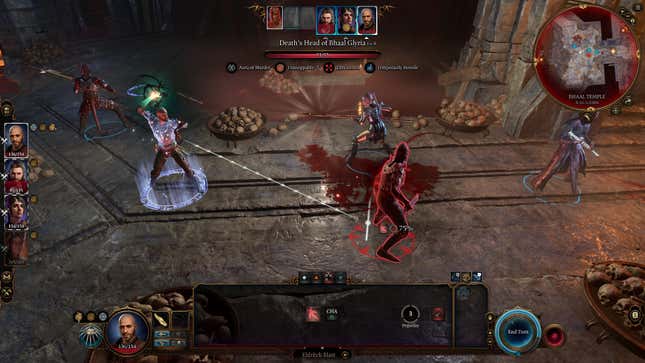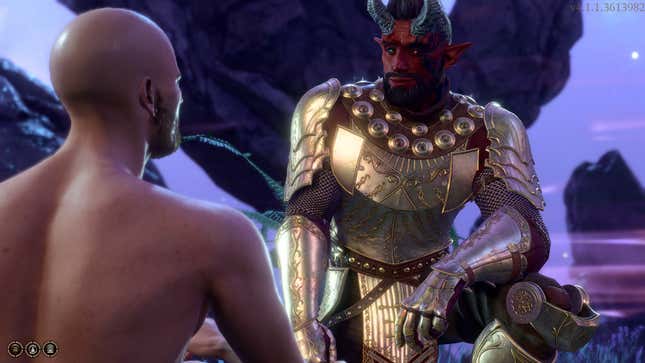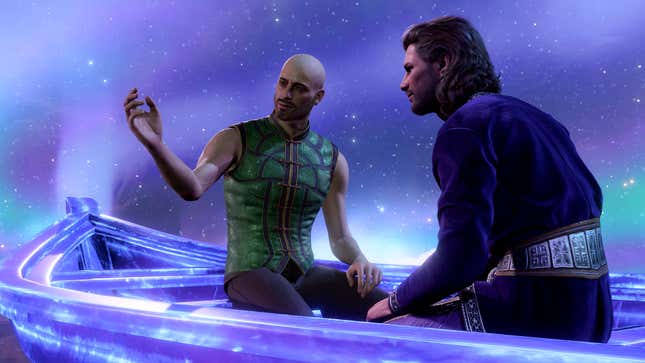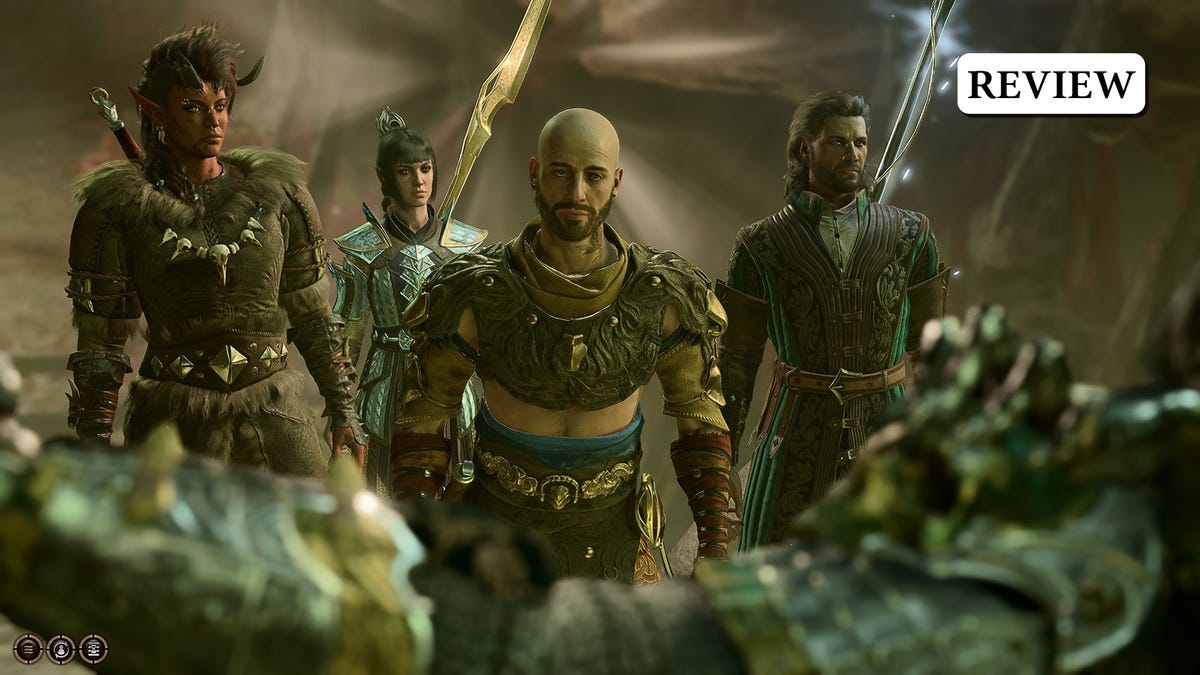Baldur’s Gate 3 has been propped up as a big-budget, computerized approximation of a tabletop role-playing game, but that’s not entirely accurate. Sure, as an RPG rooted in Dungeons & Dragons’ Fifth Edition ruleset, complete with dice rolls, big decisions, and enough customization options for your build, appearance, and backstory to fill a million character sheets, Baldur’s Gate 3 is an embarrassment of riches for the sickest of roleplaying sickos. But ultimately, as a video game that has to be programmed by people and therefore beholden to the finite possibilities the makers at Larian Studios were able to account for, it can’t quite match the expansive breadth of possibility that comes from a group of friends gathered around a table, riffing on each other’s ideas and “yes-anding” into different scenarios that completely derail the original plan. But damn, Baldur’s Gate 3 sure does a stellar job of emulating the concept.
In my first playthrough, I played a Warlock whose primary motivation in the world of Faerûn was self-preservation. I poured points into my Charisma stat, which made me a smooth enough talker that I could often charm my way out of fights rather than losing time and resources to a long, strategic battle. As I sorted out my character’s story in my head, I expressed it in dialogue, the spells I cast, and even the armor sets I wore as I wrote his tale with each decision, big and small.
Buy Steam gift card : Amazon
The more I filled out who my hero was, the more I pushed up against the boundaries of what I thought Baldur’s Gate 3 could accommodate. And surprisingly, at several points where I thought I’d feel the game resisting my role-playing, puzzle-solving, or tactical decisions, Baldur’s Gate 3 instead impressed me by being reactive to my choices. The game is so systemically dense, to the point of being overwhelming, but that density brings with it the kind of room for experimentation and expression that most games of this scale only dream of. I imagine that, as I do future playthroughs and the community pokes and prods at the code to see what is possible, those boundaries will become much more apparent, and the illusion will be shattered. But my first Baldur’s Gate 3 playthrough felt like an incredibly tight Dungeons & Dragons campaign that let me express myself in ways I didn’t think it could.
The enemy of my enemy is my begrudging ally
Set in the famous Dungeons & Dragons world of Faerûn (aka The Forgotten Realms), Baldur’s Gate 3 focuses on a group of disparate adventurers who are abducted by Mind Flayers—arrogant, squid-faced aliens who seek domination over all. Aboard the Mind Flayers’ ship, you and several others who may or may not join your party are infected with parasitic tadpoles that threaten to take over your brains and eventually transform you into tentacled beasts yourselves, sworn to serve as part of the Illithid hive mind. With characters like the devout (and deeply racist) Cleric Shadowheart, the ambitious and self-destructive Wizard Gale, and the pretty much unambiguously evil vampire Rogue Astarion, Baldur’s Gate 3’s cast is the definition of dysfunction. They’re complicated, and all have some greater issues going on beyond the tadpoles in their brains. This group could not be less suited for each other, and yet they’re stuck traveling the world together in search of a cure for their affliction. It’s a recipe for great adventure.

Peeling back the layers of Baldur’s Gate 3’s systems was challenging, satisfying, and rewarding, but it was peeling back the layers of the game’s gaggle of messy, magical fuckups that I found most compelling. In Karlach, the Tiefling Barbarian with an infernal engine in her chest slowly killing her, I found my ride-or-die tank who was a constant reminder that life is worth living beyond just mere survival. In Shadowheart, I found my foil as her devotion to her deity ran at odds with my godless heathen of a Warlock. In Gale, I found my lover who painted my name in the stars and imagined a world for us after the tadpoles were excised from our minds, even as he struggled to put his own magical hubris aside.
Baldur’s Gate 3 invites friction between you and your party. Even as I tried to find a playthrough where I made everyone like me, a lot of those relationships ended up feeling like, at best, a begrudging respect more than a friendship. This was further compounded by dice rolls and stat checks throughout their stories that would determine if I could even accomplish things that might improve or detract from our relationship. Baldur’s Gate 3’s relationships feel like they exist on shaky ground, as self-preservation is the only thing that binds you together at the beginning. There is no great cause that everyone is sticking to for their moral code. We all want to survive and maintain our personhood. Some of these would-be Mind Flayers were my rocks, others were merely another sword in the fight.
I have to give Larian Studios’ writing team their flowers, because whether I was watching a small aside between party members at camp or Gale was making an incredibly grand, poetic gesture as our love story unfolded, I was hooked in by the clarity of voice for each of these characters. Of course, you don’t have to have all of them in your party, and if you’d like, you can also choose to play as one of them rather than creating your own character.
This works as a quick way to jump into the game, and it will give you a deeper look into that respective character’s backstory, but I personally recommend you make a custom character in your initial playthrough and experience each of these people as party members first. Playing as your fave is cool, but it does mean you’re inserting your interpretation of them in a run rather than seeing how their story plays out. It creates an interesting “what if” scenario, but I wouldn’t call it the optimal way to experience these characters firsthand.
Speaking of optimal first playthroughs, I also recommend you do a solo run before playing it cooperatively. Baldur’s Gate 3 lets up to four players party up and play through the game together, which can create new brands of chaos and connection (no, you can’t enter relationships with each other, sorry), but it feels like a riff on the core game’s experience best kept for a second playthrough after you’ve seen the story through by yourself.
Buy Steam gift card : Amazon

Where RPG meets immersive sim
Playing through the game by myself gave me a better understanding of not only the party, but of Baldur’s Gate 3’s systemic depth. Its best combat moments are when you find great synergy between your party members, rather than just spamming your hardest-hitting abilities to numbers go up and down. For instance, having Gale cast an area-of-effect spell like Cloud of Daggers, which creates a small tornado of daggers in an area, can be quite useful and devastating on its own. But taking advantage of it by having my character’s upgraded Eldritch Blast push an enemy into the vortex of death offers a simple demonstration how all these interconnected systems fit together, and how you can use that to your advantage. With each level gained, my team unlocked new abilities that opened up new dimensions to a game that was already threatening to overwhelm me. Even as I fell into combat patterns and bread-and-butter combos, if I hovered over a new ability long enough, my mind would race with all the ways I could use it to expand my huge arsenal.
As simple as a Cloud of Daggers and Eldritch Blast combo sounds, that’s nothing compared to just how expansive Baldur’s Gate 3’s systems get, and I was routinely surprised by how reactive the game was to different combinations and creative solutions. The potential for these really clicked for me during a mid-game dungeon, where I was faced with a puzzle in which I needed to reach a switch in the middle of the room that was protected by a force field. There was an entire puzzle I could solve to get past it, complete with environmental hazards and traps that threatened to end my journey. But after some time attempting to do things the long way, I decided to work smarter instead of harder. I cast Gaseous Form, which let my character transform into a cloud of smoke that could levitate off the ground and freely move around the room. In this state, I was able to fly over whatever sensor would set off the force field, and reach my objective without even having to finish the puzzle.
Baldur’s Gate 3 is so much more than a tactical RPG. It gives you a series of tools that you’re free to use however you like with minimal restrictions. It feels like an immersive sim, in that it encourages creative problem-solving by leveraging the environment just as much as your abilities. Once I finally realized I didn’t have to be in combat to use my abilities, the potential of my team’s capabilities opened up in my mind. I started approaching situations realizing I didn’t have to take the most obvious route. From then on, I was teleporting past obstacles, or turning invisible and running past armed guards to find a fast-travel point on the other end to bring in the rest of the team. Hell, turning invisible also comes in handy when you have to pick a locked door and don’t want to get caught. It was wild to me by the end how obvious these solutions were because these are the same practical uses these abilities would have in a tabletop campaign.
There were several times when I would go through a situation thinking I’d done all I could to prevent something from happening, only to talk to another player and find out they managed to accomplish something I didn’t think was possible. By the end, Baldur’s Gate 3 was a game of making decisions and living with them, but realizing there was probably a strategy I either didn’t think of or didn’t have the resources for that could have fundamentally changed an encounter or story beat.

Experimental thinking is key to navigating the world and fighting your way through it. Baldur’s Gate 3 isn’t a grindy RPG. In fact, your character can only reach level 12, but each new level is a significant leap for your arsenal. Succeeding in a combat encounter is almost never a matter of being underleveled, it’s about being underprepared and having no plan. The hardest fights in Baldur’s Gate 3 weren’t because I was overpowered by my enemies; they were because I was outplayed by them. I might spend a few turns funneling damage onto the opposing team’s heaviest hitter and taking them out, only to realize the enemy had flanked me in the process. That’s where position-based abilities like Dimension Door or Misty Step came in, letting me teleport my team across the battlefield the same way they transported me past an obstacle. Baldur’s Gate 3 gives you abilities and tells you to find practical use for them in any scenario, and that’s what makes it exceptionally rewarding.
With density comes friction
Sometimes that depth comes at a cost, though. Baldur’s Gate 3 throws you into the deep end, which makes it a challenge, but some of that difficulty comes from a lack of clarity. The game’s journal is especially vague, and I would often find myself bashing my head against a wall trying to figure out something a quest description was hinting at, ultimately not realizing that the information I needed was in a seemingly unrelated side quest on the opposite side of a map. It can fall into convoluted adventure game logic, and it can confound and frustrate in a way that no difficult fight will. But I can’t deny it was extremely satisfying to finally figure out what Baldur’s Gate 3 was asking of me, even if it felt like I’d wasted hours of my time getting there. Some of this feels in service to the open-ended core of its design, but a more expository journal would’ve saved me a lot of headache.
Buy Steam gift card : Amazon
Can a video game capture the freedom of imagination? It can certainly try
When all is said and done, video games and the people who play them are often limited by what’s coded, put on a disc or digital store, and we make do with what we’re given. Developers offer as much freedom as they can while making something that is crafted and distributed to millions of people, and then players push against the walls until they break. Even games that rely on technology like procedural generation are limited by systems developers build and the verbs we as players utilize to exist with them.
For all of Baldur’s Gate 3’s freedom of expression, it will, one day when we’ve all played through it dozens of times, show itself to be another game beholden to the same things all games are. Nothing can ever truly recapture the freedom that imagination brings to a tabletop game. But Baldur’s Gate 3 is proof that Larian Studios knows how to capture that spirit and develop in pursuit of that feeling. It’s unreasonable to hold other RPGs to such a standard. As others have said, Baldur’s Gate 3 is an anomaly in how games of this scope are developed. This only happens when a studio has years of development time and an early access period in which to work out its vision alongside a tuned-in community. If nothing else, it’s less a new standard to hold other games to and more a reminder that the industry seldom lets games cook this long to achieve the things Baldur’s Gate 3 does. It’s a shining example of both the limitations of video games as we know them, and the possibilities they can hold.

I want to play Baldur’s Gate 3 again. I want to go back and save the friends I couldn’t save, fix the things I couldn’t salvage. But I also want to reflect on how I got where I did in the end. Yes, I walked the sprawling paths Larian set out for me, but the story was mine, and I walked into every decision I made with a mix of trepidation and confidence. I feel a certain ownership of my accomplishments, mistakes, and relationships. I could spend another 50+ hours replaying and throwing myself against the walls to see if I can break them, but right now, my Warlock is sitting in the center looking upon all the ruin, the love, the hate, and the hope left in his wake as he sought to save himself, his friends, and his lover.
I can try a new playthrough and build things back up and game the system to get the “better” outcome where the dice roll in my favor every time. But there’s something kind of beautiful in a messy playthrough that you can’t experience more than once as each permutation becomes more apparent with each replay. For now, this imperfect outcome is mine, and I want to maintain that memory of my Baldur’s Gate 3 story. At least for a little while longer.
Buy Steam gift card : Amazon


